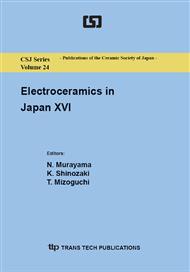p.149
p.153
p.157
p.161
p.165
p.169
p.174
p.181
p.185
Preparation of BaZrO3 Nanocrystals at Low Temperature
Abstract:
Barium zirconate (BaZrO3) was prepared by the composite-hydroxide-mediated (CHM) approach at low temperature. The CHM method is based on chemical reactions of materials in the eutectic hydroxide melt. In this method, the eutectic point at an sodium hydroxide (NaOH) : potassium hydroxide (KOH) molar ratio of 51.5 : 48.5 is about 165°C. In the present work, the low-temperature preparation and morphology of BaZrO3 nanocrystals were investigated. Zirconium tetra-n-butoxide ((CH3CH2CH2CH2O)4Zr) and/or zirconium dioxide (ZrO2) were used as a zirconium source. X-ray diffraction measurements confirmed that the BaZrO3 had a perovskite structure. Barium hydroxide (Ba (OH)2) was used as a barium source. BaZrO3 nanoparticles were obtained when (CH3CH2CH2CH2O)4Zr was used as a raw material. On the other hand, BaZrO3 nanocubes were formed when ZrO2 was used as a raw material. Scanning electron microscopy and transmission electron microscopy observations indicated that BaZrO3 nanocrystals were formed.
Info:
Periodical:
Pages:
165-168
Citation:
Online since:
September 2013
Authors:
Keywords:
Price:
Сopyright:
© 2014 Trans Tech Publications Ltd. All Rights Reserved
Share:
Citation:


